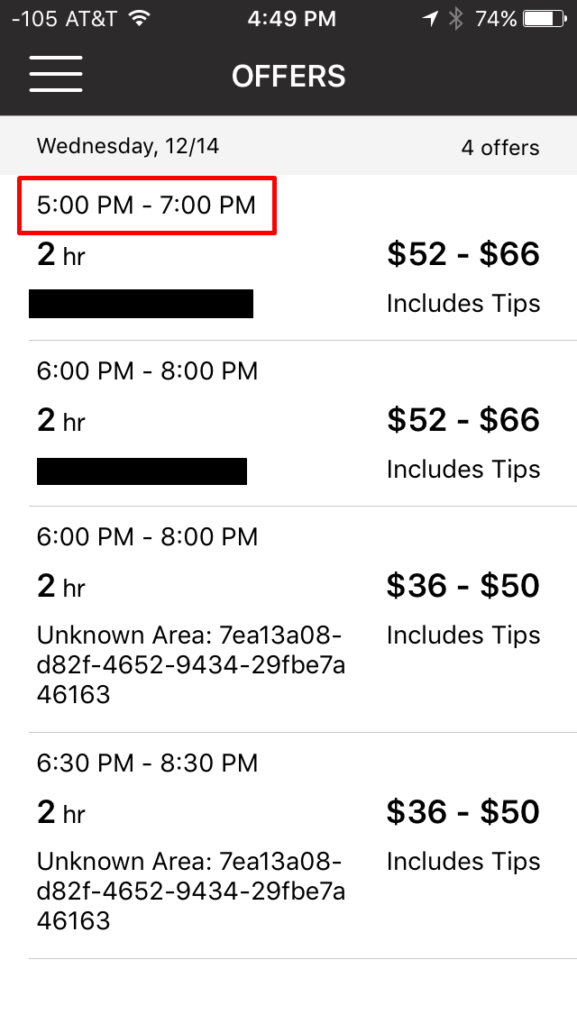If you search for available blocks using the refresh method in the Amazon Flex app, you will come across a variety of delivery block times. Because the majority of Prime Now deliveries are for 2 hour delivery windows, most Amazon Flex delivery blocks are also in 2-hour increments that match those windows. Sometimes, however, you will see an offset shift, where the delivery block does not match up with a Amazon Prime Now delivery timeframe. For example, see below for an available 5 PM – 7 PM delivery block, which is considered an offset shift because it neither matches up with the Prime Now 2-hour delivery timeframes of 2 PM – 4 PM nor 4 PM – 6 PM.
When you are assigned a delivery block that does not match the 2 hour delivery window, however, several things about your deliveries can be different. Read on to find out what you can expect and how to take advantage of this!
What you can expect
If we take the example above for the 5 PM – 7 PM delivery block, when you arrive at 5 PM (or 4:45 PM as you should!), all deliveries for 4 – 6 PM have already gone out, but it is too early to begin deliveries for 6 – 8 PM deliveries even if the orders have already been placed. The reason for this is that the recipients may not be home before 6 PM, and this can also set unrealistic expectations for Amazon customers regarding earlier than expected delivery.
The primary reason Amazon has these delivery blocks is so that drivers are available on stand-by to either deliver 1-hour delivery orders, and follow-up on any undeliverable packages returned to the warehouse. In reality, however, you will find that you will spend much of your time waiting at the warehouse.
Once you approach 6 PM, you will likely be assigned deliveries for the 6 PM – 8 PM Prime Now delivery window. The deliveries will only be for a half-route, since you only have 1 hour left in your delivery.
Fewer deliveries, less tips
As you can see, there is a good chance you will spend much of your time waiting at the warehouse during the first hour and only delivering a half-route during the second hour. You will therefore not tally up as many deliveries during the delivery block, which will help reduce your driving costs, but also decrease your tip potential. Since tips typically outweigh costs slightly, these offset shifts may generate slightly less income for you per hour.
More geographical flexibility
Because the deliveries are not full-routes, there tend to be fewer pre-programmed routes. For example, you will not receive a delivery slip that you normally would during a full delivery route. What this means is that the warehouse attendants have more discretion in assigning routes based on preference. Need to head to the east part of town after your delivery block? Ask the attendant if there are any packages that need to go in that direction, and they may be able to help you out. This can be a great way to save on vehicle costs as well as time.
Return to station?
By default, the Amazon Flex app seems to code offset shifts differently, and will typically direct you to return to the warehouse after completing your deliveries. If you make a 1-hour delivery during your first hour, it is obviously expected that you return to the warehouse. But because the way it is coded, after you complete a delivery during an offset shift, even if there are only 30 minutes left in your delivery block and you are still 20 minutes away from the warehouse, you may still be directed back to the warehouse by the Amazon Flex app. When this happens, call the Amazon Flex support line and let them know your situation. In most cases, they will confirm that there are no additional deliveries assigned to you, and agree that it would be pointless for you to return to the warehouse with only 10 minutes left on your delivery block. It is always a good idea to call support so that you have a record of this conversation and “permission” from Amazon should there be an issue at a later time.
Is it a good idea?
You may get paid less per hour due to lower tips, but if you can take advantage of downtime by doing other tasks, you can effectively boost your hourly wage by quite a bit. Because you will not be doing full delivery routes, the routes are less challenging and will typically be easier to complete on time. Furthermore, due to additional flexibility, you may be able to further cut your vehicle costs by making deliveries that are in geographical areas that you would like to end up in after the delivery block.
Any thoughts or experiences that agree or disagree with what we posted? Please share below!
